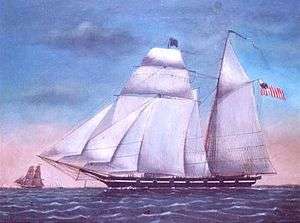USRC Crawford (1830)
The United States Revenue Cutter Crawford was the first of the 13 cutters of the Morris-Taney Class to be launched. These cutters were the backbone of the Service for more than a decade. Samuel Humphreys designed these cutters for roles as diverse as fighting pirates, privateers, combating smugglers and operating with naval forces. He designed the vessels on a naval schooner concept. They had Baltimore Clipper lines. The vessels built by Webb and Allen, designed by Isaac Webb, resembled Humphreys' but had one less port[1]
 A Morris-Taney class Revenue Cutter | |
| History | |
|---|---|
| Namesake: | William H. Crawford |
| Builder: | Webb and Allen, New York |
| Completed: | 1830 |
| Commissioned: | January 1830 |
| Decommissioned: | 27 July 1835 |
| Homeport: | |
| Fate: | sold |
| General characteristics | |
| Class and type: | Schooner |
| Displacement: | 112 tons |
| Length: | 73.4 ft (22.4 m) |
| Beam: | 20.6 ft (6.3 m) |
| Draught: | 9.7 ft (3.0 m) (aft) |
| Propulsion: | sail |
| Sail plan: | topsail schooner |
| Crew: | 20-24 officers and men |
| Armament: | (4) 6-9 pndrs (typical of class) |
The Crawford, named for Secretary of the Treasury William H. Crawford, initially was assigned to the Collector of Customs in Norfolk, Virginia. In June 1831, she sailed for duty at Savannah, Georgia, arriving on July 1, 1835. The Government sold her in 1835 for $2,300.[1]
The USRC Swiftsure (1825) was renamed Crawford on 31 December 1835 and sold 1 April 1839. USRC Jefferson (commissioned in 1832), was renamed Crawford in 1839 and served until 15 December 1847 when she was wrecked near New London, Connecticut[2]
Notes
- Citations
- "Crawford, 1830", Cutters, Craft & U.S. Coast Guard-Manned Army & Navy Vessels, U.S. Coast Guard Historian's Office
- Canney, pp 14-15
- References cited
- This article incorporates text from the public domain Dictionary of American Naval Fighting Ships.
- "Crawford, 1830" (asp). Cutters, Craft & U.S. Coast Guard-Manned Army & Navy Vessels. U.S. Coast Guard Historian's Office. Retrieved 4 November 2013.
- Canney, Donald L. (1995). U.S. Coast Guard and Revenue Cutters, 1790–1935. Naval Institute Press, Annapolis, Maryland. ISBN 978-1-55750-101-1.